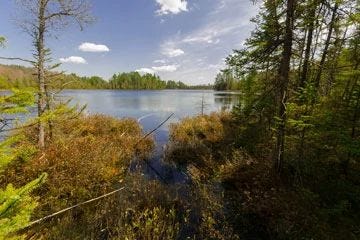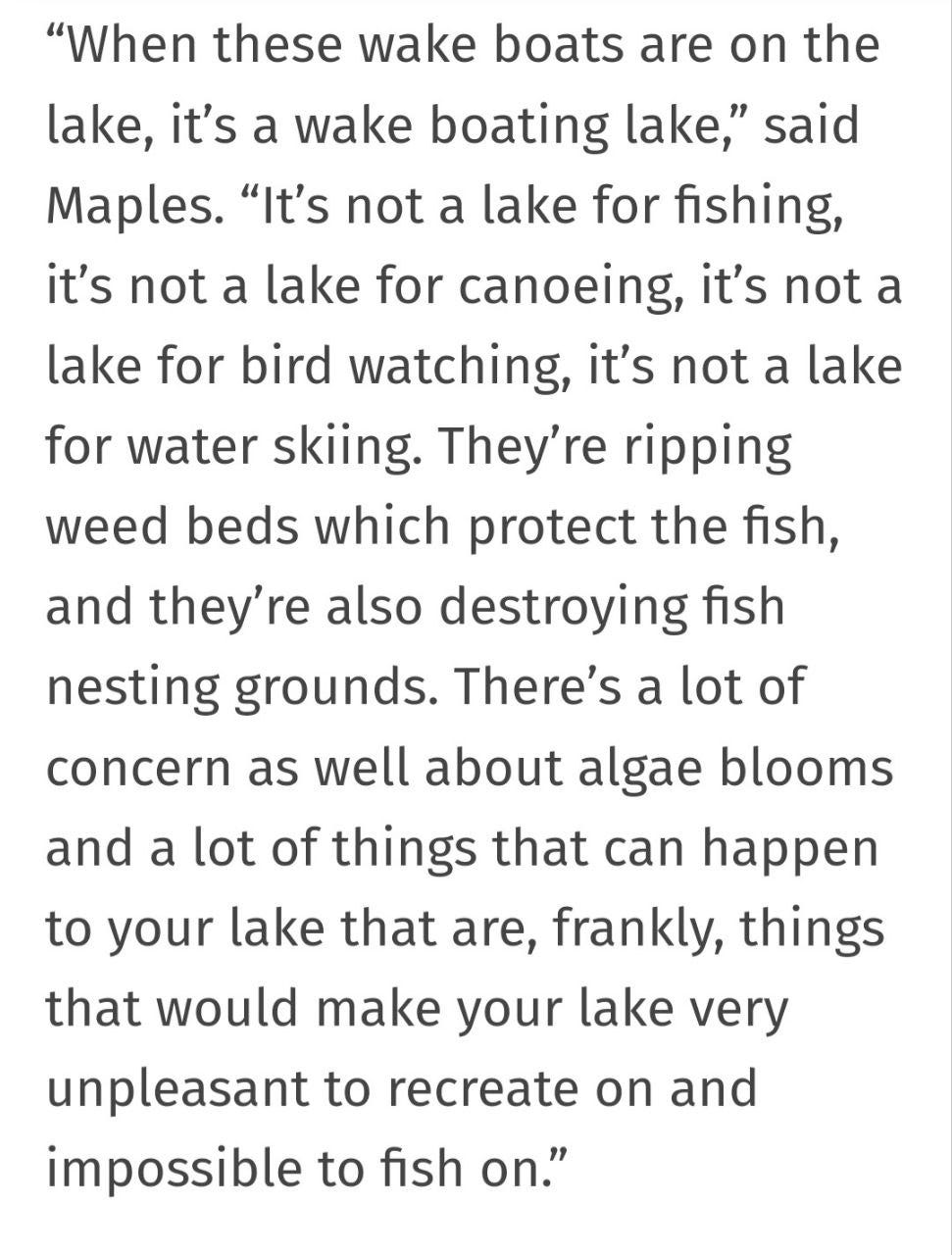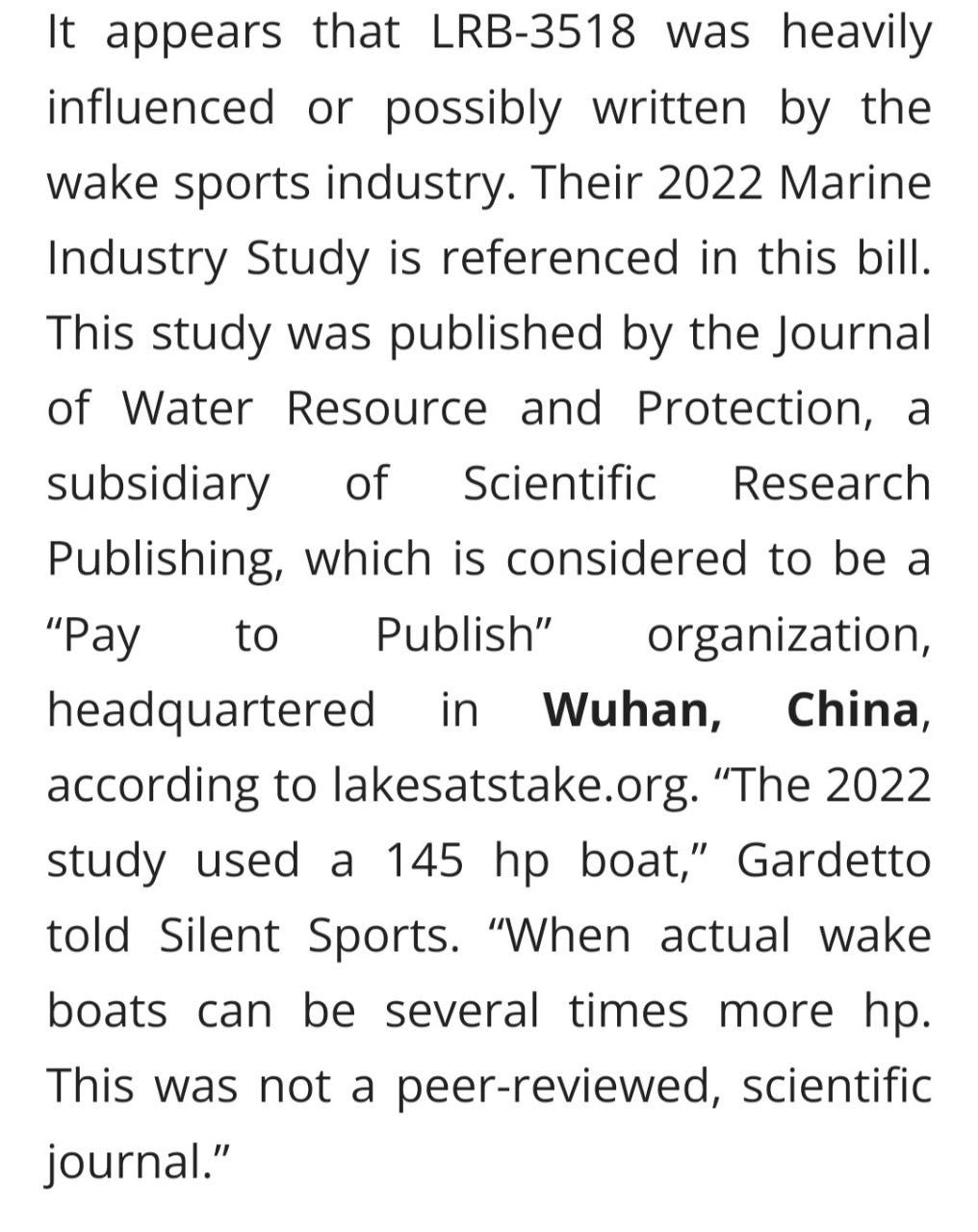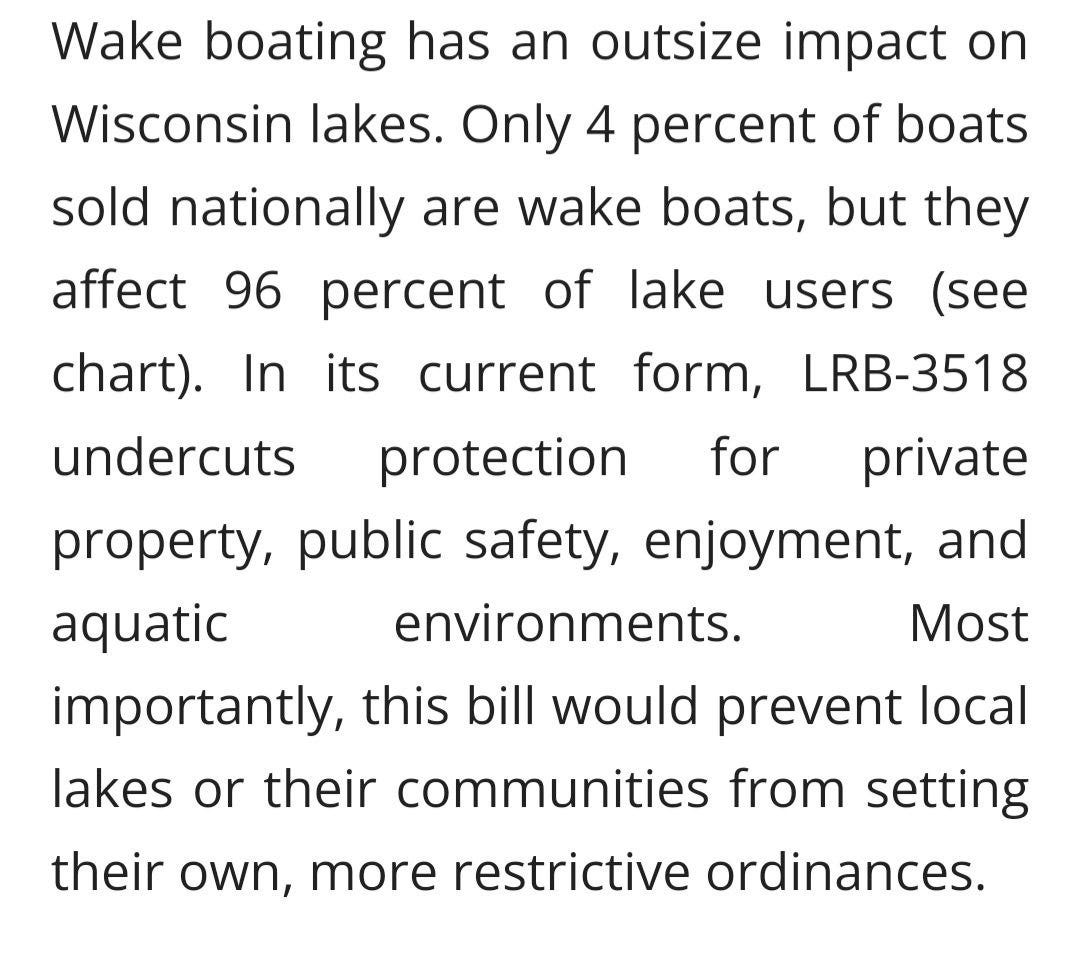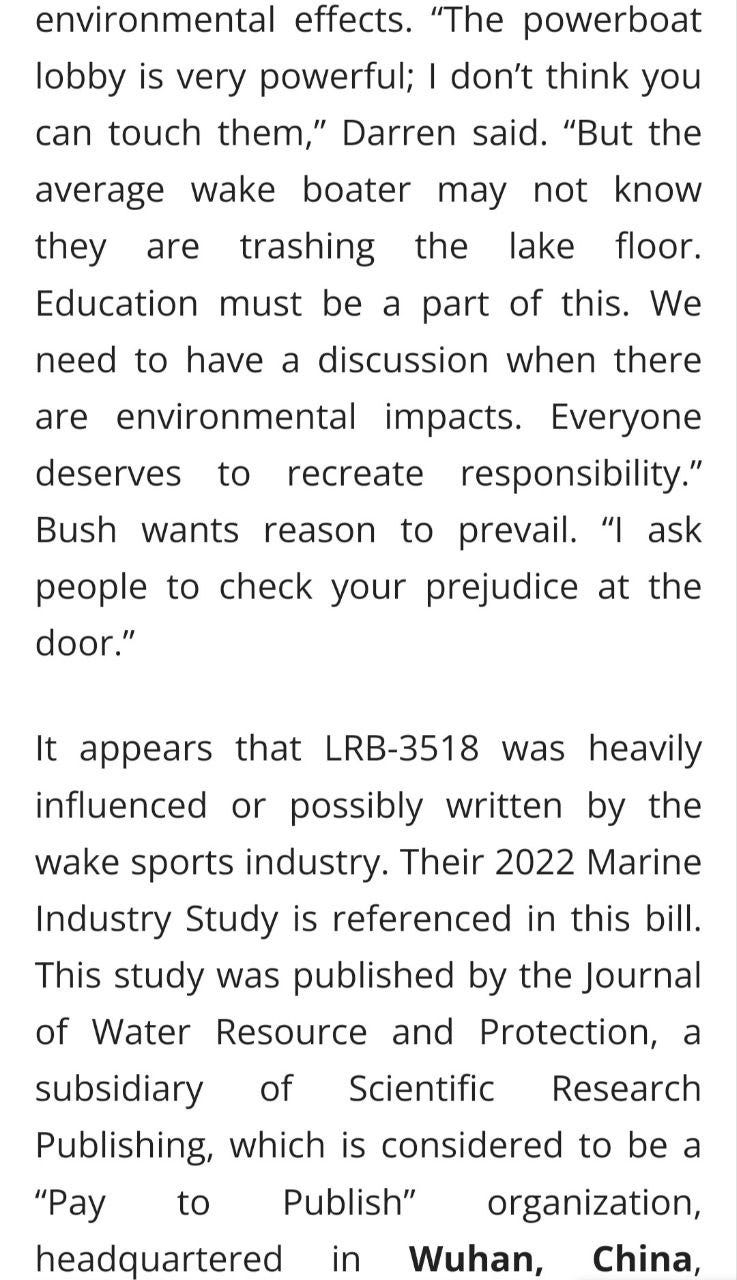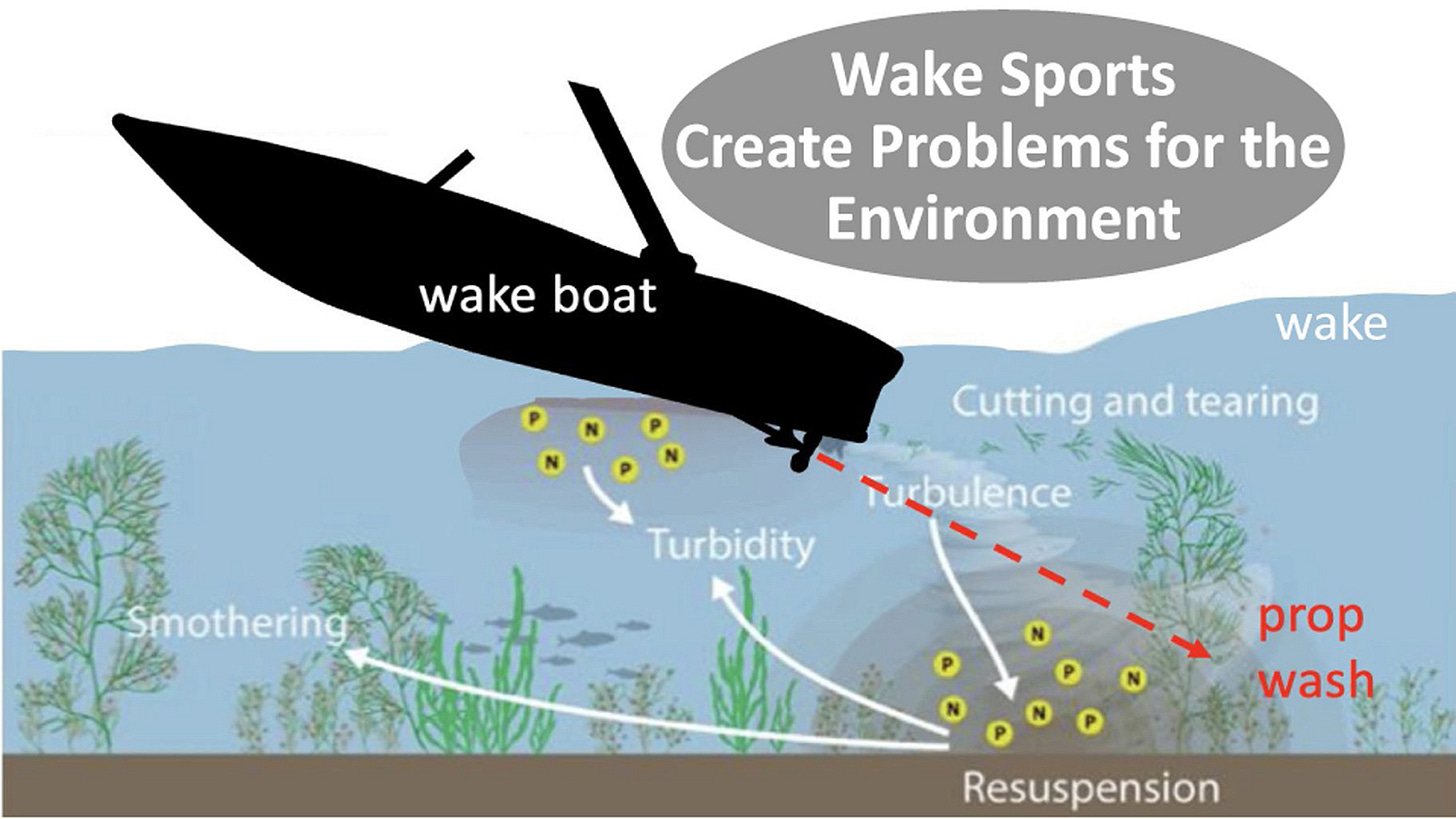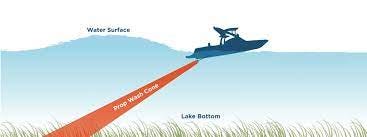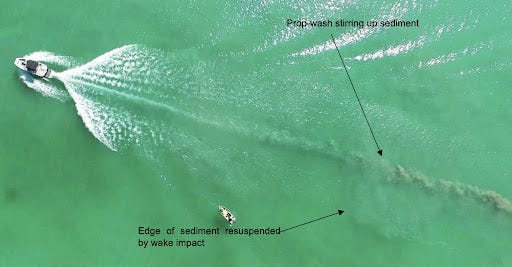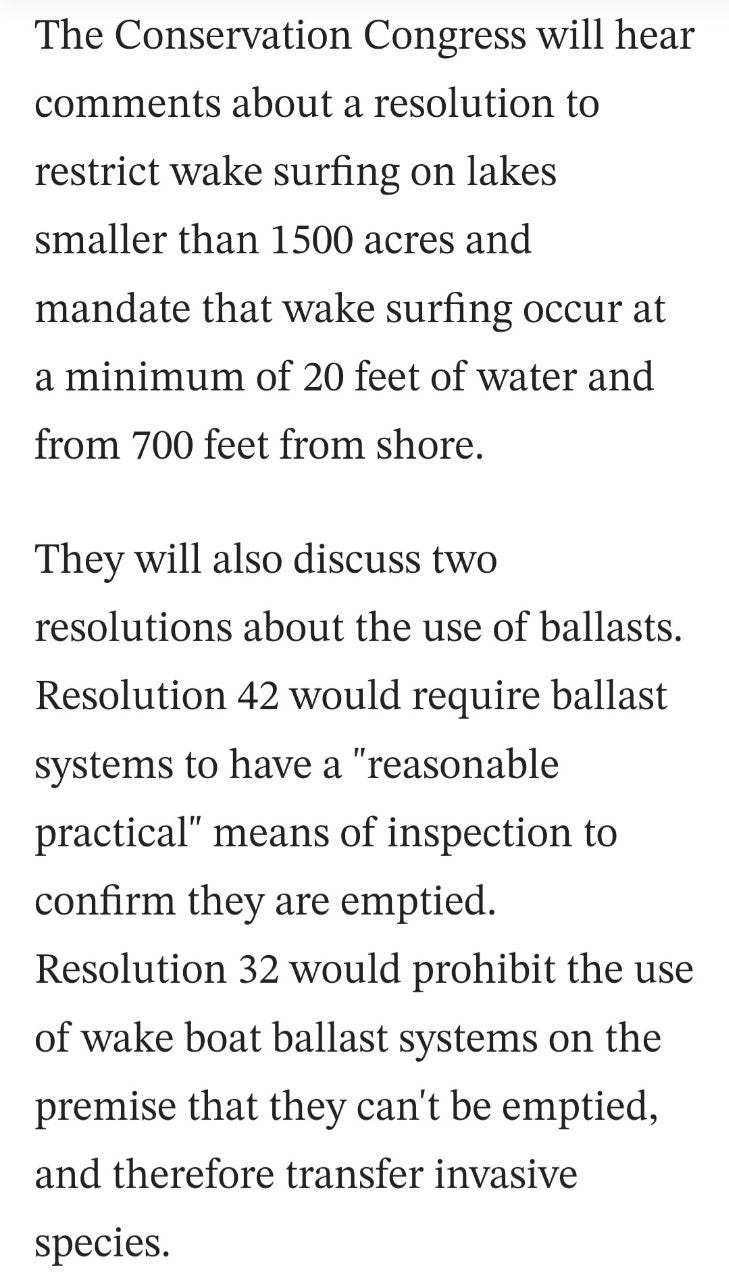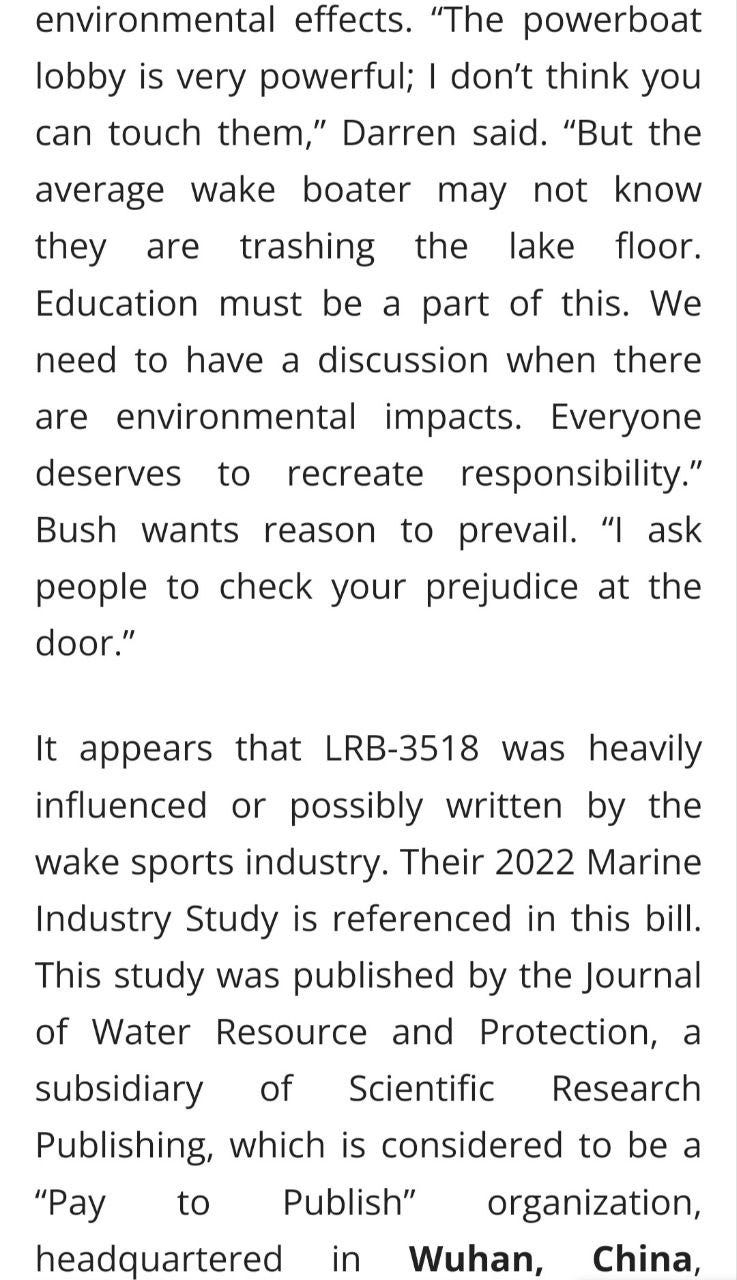"Wakeboats" are killing America's small lakes
I’m going to diverge a little from my usual political discourse today and talk about something near and dear to my heart - the quality of water in our lakes & rivers, how it’s changing, why I think it’s changing and what we can do about it.
I’m going to focus specifically on what is going on with Wisconsin lakes in this newsletter - since I live there now - but the research I did applies to every state in America. I hope you can take my research and replicate it for your own area.
For the most part, lakes are generally sub-divided by size and depth.
Wisconsin has the third largest concentration of fresh water lakes in the world - so keeping them healthy is important not only to the state, but to America. Wisconsin has about 15,000 lakes - of those some 40% are named.
However, only 4.5% of Wisconsin's lakes are larger than 200 surface acres and considered larger bodies of water.
Many of the smaller lakes in Wisconsin are also shallow lakes. Shallow lakes are bodies of water that are less than 20 feet deep, with an average depth of less than 10 feet.
That means of the 15,000 lakes in Wisconsin - only around 1,000 are considered “larger” bodies of water and are suitable and deep enough, IMHO, for high-wake boating activity.
Some 14,000 of the 15,000 lakes are more suitable to fishing, canoeing, kayaking, pontoon riding and low-wake boating activity.
Why is this true? Well, it’s important to understand what makes shallow and small lakes different than bigger, deeper lakes…
The water quality in small, shallow lakes generally exists in one of two alternative states: 1) the algae-dominated turbid-water state or the 2) plant-dominated clear-water state.
This has historically been true - it’s not some recent phenomena.
The turbid-water state is characterized by dense algae, an undesirable bottom feeding fish community and few aquatic plants. The clear-water state is characterized by abundant aquatic plants - including wild rice - a greater number of zooplankton, and a diverse and productive gamefish community.
In other words - aquatic plants are the key to clear water in small, shallow lakes. A small, shallow lake that is free of both aquatic plants and algae is uncommon and unrealistic.
A mechanism that displaces aquatic plants and allows for algae, turbid water and invasives to take over is called a forward switch. In Wisconsin - in the past 10 years - many lakes are experiencing forward switches that appear to be changing the water quality of Wisconsin’s small, shallow lakes.
Many Globalists and progressives want you to believe that the forward switch we are experiencing is man-made “climate change” and there’s nothing we can do about it other than reduce our “carbon footprint” and block the sun. I disagree - here’s why. I believe the change is man-made but it has nothing to do with “climate change.”
Many small, shallow lakes in Wisconsin are experiencing a forward switch to algae-dominated turbid-water lakes due to phosphorus increases in the lake and the loss of aquatic plant life.
The question is – why now suddenly – after 100 years of pretty consistently clear water is the water becoming more turbid? Let's examine the possible culprits. Herbicides, plant removal, phosphorus overload and high-wake boating. Forward switches destroy plants through harvesting or herbicide use and repeated boat usage that damages aquatic plants beyond recovery.
Aquatic plants and wild rice absorb excess phosphorus suspended in small, shallow lakes - to keep it from forming algae - and they help keep our lakes and water clear. Aquatic plants can actually filter and clean total phosphorus concentrations below about 25 to 50µg/L. When total phosphorus levels become greater than about 50µg/L - algae-dominated systems will take over.
WILD RICE AND GOOD AQUATIC PLANTS ACTUAL CLEAN THE LAKE WATER. They take a tremendous amount of nutrients and phosphorous from the lake water and the lake sediment. The roots of aquatic plants help to hold phosphorus and sediment in place - on the bottom of the lakes - so it does not get re-suspended in the water causing increased turbidity, green or dirty looking water.
Wild rice and good aquatic plants are very efficient at pulling excess phosphorous directly from the surrounding water, removing it before algae, that can turn the water green, can use it. They also provide a nursery for young fishes and offer them protection from predation.
In addition to turbidity & algae, in the past few years, many of Wisconsin’s lakes have also experienced an unexplained growth in “invasive” species - many which strangely originate in Asia and Communist China:
1. Eurasian Water Milfoil, 479 lakes affected
2. Rusty Crawfish, 456 lakes
3. Curly Pondweed, 307 lakes
4. Chinese Mystery Snail, 217 lakes
5. Zebra Mussels, 121 lakes
6. Banded Mystery Snail, 105 lakes
Where are these invasive species coming from and how are they growing so fast in Wisconsin lakes?
When wild rice and good aquatic plants are removed from small, shallow lakes and phosphorus is dredged up from the bottom of the lake by aggressive boating and allowed to spiral out of control, invasive species, once deposited in a lake, take over.
Wild rice and aquatic plants are good in small shallow lakes because they take up phosphorus, emit oxygen, and provide a habitat for fish - and they remove nutrients that invasives need to flourish.
If we want to return our small shallow lakes from an turbid, algae-dominated state to a clear-water state, we need to:
· Identify the “forward switch” and remove it;
· Implement external and internal nutrient control measures;
· Reestablish the aquatic plant community, including wetland fringe; and
· Stabilize and manage the restored system to keep it that way.
SO, WHAT DO I BELIEVE ARE THE FORWARD SWITCHES THAT ARE KILLING OUR LAKES AND ALLOWING PHOSPHORUS LEVELS AND INVASIVES TO SPIRAL OUT OF CONTROL IN SMALL, SHALLOW LAKES? HERBICIDES, PLANT REMOVAL AND HIGH-WAKE BOATING.
I’m not alone in this view. Thousands of Wisconsin lakeshore owners are lobbying the state to pass restrictions on high-wake boating - on small, shallow lakes.
What do you need to know about wake boats and how are they different from other boats? Here’s a primer - but the most important thing I learned about this is that the wake boat lobby is very powerful and it’s FUNDED BY THE CHINESE COMMUNIST PARTY out of Wuhan, China. You can’t make this stuff up. COINCIDENCE? I DON’T BELIEVE IN COINCIDENCES.
If you only remember one thing from this newsletter - remember that.
The same place where the COVID virus came from - a lab in Wuhan, China - is also where they are writing position papers pushing wake boats in America. The CCP, our enemy, and a friend to Russia/Iran, definitely has a motive to destroy our health, control our elections and destroy our water. This is not nothing - this is everything!
Communist China didn’t just send 26,000 military age men over our open border to go to Disneyland! They have plans!
So, let’s examine why wake boats are harmful to small, shallow lakes.
SIERRA CLUB: What is a wake boat?
One type of vessel, the wake boat, is exceptionally destructive if operated without care. Tanks at the back of these boats take on thousands of pounds of lake water to increase their weight, a design that causes them to ride bow-up and stern-down. Coupled with powerful motors pointing their propeller at a downward angle, the boats produce strong high-energy wakes and propwash. This allows people to surf untethered behind them.
Just one pass of a wake boat can be devastating to an ecosystem. Multiple passes in the same area cause long-lasting damage to shorelines, water quality, and lake bottoms.
Wake boats erode vulnerable shorelines when the distance to shore is not adequate to dissipate the wakes. The wakes can also damage docks, swamp other boats, endanger swimmers, and destroy waterfowl nesting sites.
The downward angle of the propwash from wake boats causes algae blooms by stirring up sediment and reintroducing sequestered phosphorus and nitrates into the water column. Lake water is warmed by this increased turbidity - killing plants and helping algae and invasives to flourish.
Aquatic Invasive Species (AIS) are pumped into the ballast tanks of wake boats along with lake water. These tanks are difficult to clean and end up spreading AIS to other waterbodies. Until the boating industry improves the tank-cleaning process, wake boats will continue spreading AIS. Communist China knows this - that’s why they want all of our small lakes to be infected by wake boat ballasts filled with invasives from Asia.
State legislatures across the country are struggling to weigh the impact of wake boats on the environment, public safety, and the economy. But the wake boat lobby is powerful!
Each waterbody has unique characteristics regarding water quality, shoreline vulnerability, lake bottom types, sequestered contaminates, animal habitat, accessibility, and historical use. Designating waterbodies as “wake boat safe” will not only protect the environment, but also help wake boaters know where they can operate without fear of damaging aquatic ecosystems.
WILDERNESS ALLIANCE: What is a wake boat? Wake boats are boats designed to create big waves – waves far larger than created by even the largest ski and fishing boats now on our lakes. Wake boats make waves so large that they can be surfed without a tow rope, like waves in an ocean.
Are wake boats always a problem? No, when operated in deep water on large lakes, far from shore and smaller boats, wake boats meet acceptable environmental and safety standards.
But, Wisconsin’s lakes are typically shallow, relatively small, have natural shorelines and soft lakebeds. Wake boats are not suited for most Wisconsin lakes. They create waves far larger than waves from wind or from ski boats. The lakebed scouring is vastly greater than with other boats whose propellers aim out, not down.
Aren’t wake boats just a slightly larger challenge than other boats? No, wake boats present major new threats:
1) The biggest waves our lakes have seen – Wake boats make much more powerful waves than ski boats. A ski boat is designed to ride on a plane atop the water, making the smallest wake possible. A wake boat does the opposite – it is designed with ballast tanks to tilt the stern down to maximize water displacement and plow through the water, throwing up huge waves. It deploys special fins to maximize wave height and shape.
2) Lakebed scouring – Wake boats are designed with the propeller angled downward under the boat, a full 4’ below the surface. This directs a jet of prop wash scouring the lakebed 20’ deep! This results in mixing centuries of sediment accumulation back into the water. Think aiming a fire hose at the lake bottom.
What else does lakebed scouring affect? Lakebed scouring is a catastrophe for our pristine lakes. Scouring:
1) Churns sediment making the lake murky, destroying or silting up fish spawning areas, harming feeding by loon, otters, muskies, walleye and other sight-feeding fish
2) Reintroduces phosphorus and nutrients that have settled to the lakebed over thousands of years. This promotes algae blooms.
3) Reintroduces mercury and other heavy metals from the lakebed
4) Tears up aquatic vegetation, creating opportunities for aquatic invasives.
What about invasives? Wake boats use lake water as ballast. It must be pumped out each time the boat leaves, but several gallons are always retained in the tanks. Thus, the ballast tanks mix water from the previous lake into each new lake the wake boat enters. THEY CAN’T BE CLEANED.
Are wake boats a threat to loons? Yes, particularly from late May to early July when loons nest. The large waves wash over and destroy loon nests in reed beds or on shore just inches above the water level. Also, the increased murkiness of water churned by wake boat prop wash decreases the ability of loons to feed.
What other complications do wake boats create? Very large wakes present a risk for fishermen, canoes, kayaks, sailboats, paddleboards, swimmers, and water skiers. When a wake boat operates, paddle boarders, kayakers, canoers and swimmers must often get off the lake. There has even been a pontoon boat that was swamped by a wake boat’s wake.
Do wake boats affect fishing? Absolutely! A musky fisherman cannot stand in a boat and cast. A person fishing the shoreline had his anchor lifted off the lakebed and he and his boat were thrown on the shoreline.
If an ordinance is passed to create limits on the size of waves created by wake boats, what about the folks who have already bought them? The proposed ordinance targets deliberately enhanced waves. Wake boats could continue to operate like any other safely operated watercraft.
There is a small, shallow lake near me that has seen diminished water quality since ONE LANDOWNER bought a wake boat and uses it regularly on the lake. He’s the ONLY one. It’s loud and destructive. Every time he uses it - the water turns brown and green. It’s obvious as night and day. I contacted him to show him my research. He dismissed me immediately and said it was NOT his wake boat that was destroying the water quality - it was global warming! HE ACTUALLY SAID THAT.
HERE’S WHAT HE SAID: “I'm extremely worried about the water quality on my lake. But, my wake boat isn’t the main culprit. I certainly don't want to harm the lake, but watersports are a extremely valuable aspect of the cabin I cherish. Honestly, much of this water quality change is likely human-made climate change...”
RIGHT!
HERE’S HOW I REPLIED: “If you truly believe that "man-made" Climate Change (the new name for Global Warming) is responsible for the water quality changes on your lake - you wouldn't be pumping gasoline into your wake boat and expanding your carbon footprint. That's talking out of both sides of your mouth. You'd be using a kayak or canoe.
It's not the wake - it's that wake boats dig up the sediment on the bottom and spread phosphorus, algae and invasives all over the lake. That's why so many lakes are now banning wake boats 700 feet from shore and bays and in water less than 20 feet. Your lake is only 2500 feet wide and an average of 11 feet deep so wake boats can actually destroy it pretty quickly - and also kill plant life. Those are the facts.”
Two counties in Wisconsin - Burnett & Sawyer - are addressing the harm that wake boats are doing to their small, shallow lakes. Read what they are doing. Courage is contagious.
BURNETT COUNTY: There is a new threat on local lakes, and it’s coming from a recreational activity that has just started to surge in popularity - “wake boats.”
The boats are typically high-powered waterski boats with large automotive engines, with internal ballast bladders that are filled with lake water, and meant to drop the boats down deeper in the water, creating a very large wake when it travels slowly across the lake. The huge waves allow people behind the boat to “surf” without a rope or line connection, unlike water skiing.
There are already some lake associations and other bodies considering action or limits on their use.
“They can do a lot of property damage. We’re not trying to limit people’s fun, we’re just encouraging safety and pointing out lake concerns.”
The major issues have to do with the inflatable bladders, meant to drop the boats down low in the water. The bladders are filled with hundreds of gallons of lake water, but need to be drained to get on a trailer, which is where one of the concerns starts: A recent University of Minnesota study confirmed that the pumping and draining systems on the boats cannot expel all the remaining bilge water, leaving a small amount in the bladders that may be mixed with the “new” lake water at the new location.
That possible mixing of various bodies of water can lead to the spread of a multitude of invasive species and threatens waters that may have been treated prior for such threats.
But the invasive species concerns are not the only issue:
“It also does a lot of property damage on the lakes. The damage may be even worse on shallow lakes and ponds, while also causing issues with overturned docks, even knocking people out of canoes or flipping small boats over. We need to consider a way to control and possibly limit them, with enforcement considerations.”
SAWYER COUNTY actually wrote an ordinance restricting wake boats within 700 feet from shore.
No person shall operate a motorboat, as defined in 30.50 (6), Wis. Stats. On waters within the Town of Hayward, Sawyer County, in a manner to enhance an elevated wake for over 50 feet in length closer than 700 feet from any shoreline, dock, pier, raft or other restricted area(s) with the Town of Hayward, Sawyer County.
The Town of Hayward Motorboat Wake Protection Area Ordinance makes it illegal for any watercraft to make a wave 2 feet in height within 700 feet of the shoreline or other critical infrastructure.
“What it does to the bottom of a lake is very damaging, and it messes up the whole ecosystem. It goes through it stirs up all the micro-organisms.”
“Numerous studies have been conducted regarding the effects of recreational boat wakes on lakes and rivers by showing the impact they can have on shoreline erosion and sediment resuspension. Shallow lakes, shallow parts of lakes, narrow channels connecting lakes are the most susceptible to the impacts of large wake activity.”
The ordinance was issued “after receiving many complaints and request to limit wake enhancement activities damaging the shoreline and lake beds within the Town of Hayward.”
By law there is a 100-foot no-wake speed for all watercraft and that personal watercraft, such as jet skis, are required to have a no-wake speed up to 200 feet.
LITTLE ROUND LAKE - SAWYER COUNTY
Little Round Lake is approximately 200 acres and lakeshore residents have said in recent years large wake boats making those large 2 foot waves have negatively impacted the water quality.
One resident who has lived along the lake for 20 years, but did not want to be identified, said it was common for him to go out in the morning for a swim and the water was clear, but after some of the large wake boats came though the water as noticeably cloudy and silty.
“There has been definite damage to the shoreline, with exposed tree roots and a lot of sediment going into the lake, a lot more organic material than you would normally have has washed back into the lake. It affects water clarity and the silting affects wildlife in the lake.”
The man said those large wake boats that kids love to ride behind should be kept to larger bodies of water because in a small lake like Little Round Lake the waves are doing damage.
“It’s all fine and good in the middle of larger lakes, but when you’re in these little bays, you’re sending these giant waves into the short bays and mother nature was not designed to handle these giant waves, so it is undermining the banks of the lane and all the sediment and crap is washed back into the lake.”
With the large waves created in recent years by wake boats, the damage has been accelerated.
“They have just magnified the amount of damage and so these boats that were creating these big waves, especially when wake surfing and really producing big waves, so if you go along and look at properties along the shoreline, there has been extensive damage done, some of that damage will take many years to repair. I know of many property owners who are looking at rip rap (large stones) trying to repair the damage.”
“The new thing on the lake is the wake boats and you really see the waves much more aggressive than I have in the past. Those large wakeboats are an impingement on our property values. It’s washing away our shoreline. It’s a very narrow lake, a long sliver of water, but if they would use those machines on the big lake, it would be much healthier for everybody concerned, including the ducks and loons that nest along the shoreline.”
Hopefully that’s enough information to educate you on the issues and spur you to do your own research. Nothing changes if nothing changes! Godspeed.




